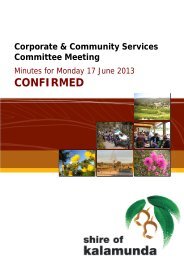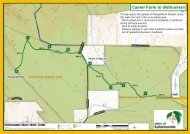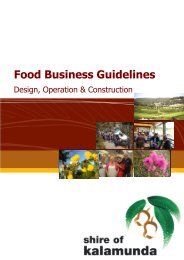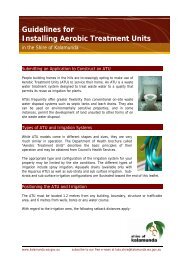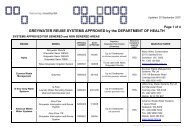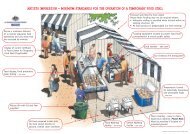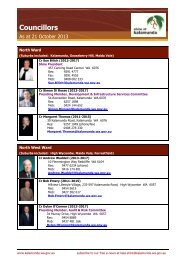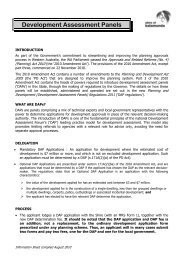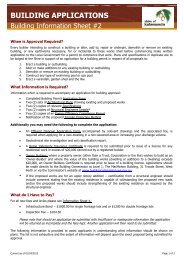Local Biodiversity Strategy: - Shire of Kalamunda
Local Biodiversity Strategy: - Shire of Kalamunda
Local Biodiversity Strategy: - Shire of Kalamunda
You also want an ePaper? Increase the reach of your titles
YUMPU automatically turns print PDFs into web optimized ePapers that Google loves.
on a natural area. While the development may be for private land, the impact <strong>of</strong><br />
development activities may frequently affect public land.<br />
This policy will detail the level <strong>of</strong> information to be provided by the proponent.<br />
Completion <strong>of</strong> Natural Area Initial Assessments could be required in order to ensure<br />
that adequate information to assess ecological viability is supplied.<br />
The LPP for biodiversity conservation will also be used to guide structure plans and<br />
outline development plans. The LPP will be applied to identify, prioritise and<br />
designate natural areas occurring within the structure or outline development plan<br />
area to be protected. Mechanisms that could be applied to protect natural areas<br />
include nominal Public Open Space (POS), POS via shared infrastructure costs or tax<br />
concession land donations made by the developer (refer to Section 11.6).<br />
The targets established in Part B will provide guidance as to which natural areas<br />
should be retained and, if possible, protected.<br />
11.4.2 LPP for Tree and Vegetation Preservation<br />
Adapting the Tree Preservation Policy will<br />
provide improved protection for all <strong>Shire</strong><br />
endemic plant species.<br />
Currently the <strong>Shire</strong> <strong>of</strong> <strong>Kalamunda</strong> has a Tree<br />
Preservation Policy that requires proponents to<br />
apply for planning approval if they want to remove<br />
more than 5 mature trees in one year. In order to<br />
fully align with <strong>Local</strong> Planning Scheme No.3 and<br />
current legislation, this policy should be reviewed<br />
and updated.<br />
As previously stated in the Section 11.3 the local<br />
planning scheme states that endemic vegetation<br />
should not be damaged, destroyed or removed<br />
unless it is in accordance with relevant state<br />
legislation, acts, regulations and guidelines.<br />
The Environmental Protection (Clearing <strong>of</strong> Native Vegetation) Regulations 2004<br />
provide the State Government legislation regarding the removal <strong>of</strong> endemic<br />
vegetation. The application <strong>of</strong> these regulations in the <strong>Shire</strong> <strong>of</strong> <strong>Kalamunda</strong> is a<br />
requirement <strong>of</strong> law. Guidance is provided by the State Government with regard to<br />
protection <strong>of</strong> the environment and biodiversity.<br />
The (Draft) Guidance Statement No.33: Environmental Guidance for Planning and<br />
Development 2005, for example, details the EPA’s broad principles for protection <strong>of</strong><br />
endemic terrestrial vegetation and flora. These principles can be used in the<br />
assessment <strong>of</strong> removal <strong>of</strong> vegetation within the <strong>Shire</strong>.<br />
Using the State clearing regulations and best practice environmental management as<br />
a guide, it is recommended that the Tree Preservation policy be updated in the<br />
following ways:<br />
<strong>Local</strong> <strong>Biodiversity</strong> <strong>Strategy</strong> Page 72



